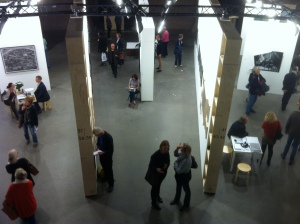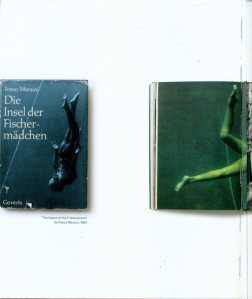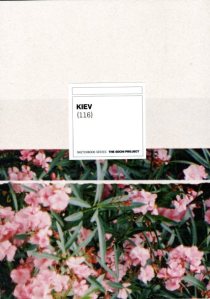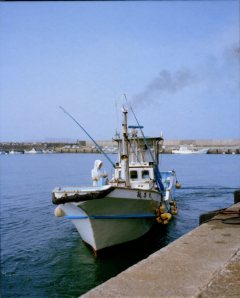UNSEEN a few highlights, some photobooks

view from the champagne bar on photo fair UNSEEN in Gashouder Westergasfabriek complex
Where do you want to go? Because NOW is the peak of photobook fairs, around the globe: Last weekend OFFPRINT was launched during the first edition of Photo fair UNSEEN at the Westergasfabriek culture park in Amsterdam. And this is the first home match of OFFPRINT, to be continued two month later, mid November, in Paris at the Ecole des Beaux Arts. In between, mid October, you might want to stop at the Frankfurt Book Fair. Some publishers will have split their activities last weekend and were at the same time present at the London Art Book Fair or at the Tokyo Art Book Fair, or maybe both. In order to move on the last weekend of September to the New York Art Book Fair (NYABF) at MOMA PS1.

stand Luiscius antiquarian showcasing art books and photobooks at OFFPRINT
Portrait photographer Koos Breukel and artist Roy Villevoye (working with the medium of photography in an antropological context on cultural codification and identity) travelled together to Papoea-New Guinea, to the village Ti, one of the most remote areas on this planet. At the entrance of the stand from publisher/designer/gallerist Willem van Zoetendaal in the Gas holder building a blow-up is mounted on a free standing wall. It is a group portrait of about 20 inhabitants of the village. They are standing, one by one, men, women and children, in colourfull western clothing (we would call it ‘vintage’ or ‘retro’ style here in the western world), on top of a mud hill, or half way down, staring at the boat coming down the Unir river, bringing the artists into their world, In fact, what you see is the following: these young and old people are completely aware, involved in this moment, each of them. They are not posing, don’t even know what that is; the SELF is not in the center of their awareness, that’s what makes these portraits so remarkable. Koos Breukel built a studio on the spot and made singular sober portraits. Villevoye made group portraits of the indeginous people. In April 2013 Van Zoetendaal will publish a book containg the portraits of all 120 villagers, photographed by both photographers on the same day.
The way the French gallery VU’ has approached the fair’s title UNSEEN is a revelation to photobook cognoscente. On one wall, which is part of the genious environmental design by Muller van Tol (just imagine slicing an orange in half and looking from above on the inner circle – containing a cafe and champagne bar- connected through long white membrans, separating the segments of fruit, that’s where the gallerists are located) several vintage photographs by Anders Petersen and JH Engstrom are lined up. This unpublished work is related to two seminal photobooks, respectively, from the series Cafe Lehmitz, 1967-1970 and Trying to dance, 1996-2001.
Julie Cockburn should have won the Dummy Award with her reworked (stitched, caleidoscopic cut-outs) found photographs presented at The Photographer’s Gallery and Flowers Gallery. She will get there anyhow; her first book will be noticed.
He has the most adaquate surname, you can imagine, looking at his first book, oblong size, entitled A Natural Order: Lucas FOGLIA. It means ‘leaf’ in Italian. Lucas himself grew up living off the land, not far from New York City – although his parents did have three tractors, four cars and five computers. The slogan of life is ‘LIVE SLOW’ and ‘DIE WHENEVER’. A photograph in the book shows this text is hand painted on Tod’s vegatable Oil Van in North Carolina. Foglia documented the principles of the back-to-the-land movement, curious to ‘see what a completely self-sufficient way of living might look like’. Lucas Foglia interviewed, photographed and befriended people throughout the Southeastern United States, maintaining a self-sufficient lifestyle, although they are not completed isolated from the mainstream. People in these communities have updated websites, lap tops, cell phones and solar panels. In his photographs the mixture of the modern world and rustic life is not made explicit, the focus is on the lather. Together with the book you receive a counter culture pamphlet, which reads like a flower-power handwritten diary, describing what a ‘100% hunted /gathered diet looks like’.
And of course I felt morally obligated to visit Yossi Milo Gallery and see the work by Pieter Hugo from the documentary series Permanent Error, 2009. Because that’s what it is, the consequence of the merging of old economy, globalization and white collar crime: a permanent error.

inside sleeve of card board fold out booklet by Rob Hornstra, KIEV (2012), from the Sochi project Sketchbook Series
In the Flatland Gallery stand I looked at tiny, pale and vurnerable young boys, lined up in their red or bleu sportswear: a group of wrestlers in Osmanyurt, in Russia, photographed by Rob Hornstra. He presented at UNSEEN the third year publication in the Sochi Project Sketchbook Series. The photographs in KIEV were taken using an old Soviet camera with technical defects. The camera was a gift to Rob Horstra, given to him during the summer of 2011 while being in Sochi, by architect, DJ and designer Pavel Lesnevsky. This card board fold-out booklet can be fold out such that you end up with two linear strips of colour photographs on summer life in Sochi on the Black Sea coast. On the back side of the zig-zag strip one large colour photograph of pink oleander bush unfolds. According to his gallerist (Flatland Gallery) Rob Hornstra now copes with the fact that it is more and more difficult to enter Russia, and might not even make it to photograph the Sochi Olympic Games in 2014. Another card board fold-out, though more intimate in size and content, and hand made, is Don’t Forget, self-published by Mariken Wessels. 14 pages concertina folding, according to the technical data. In the booklet Wessels questions the notion of memory and collective memory, repressed and forgotten memories and the distortion of truth. You can order the booklet eg. through Johan Deumens gallery in Amsterdam.

Nina Poppe, ama (2011), section of fold out with text (English and Japanese), reproduced references and glossary
Nina Poppe‘s serene book Ama (2011) presented at Robert Morat gallery, is another discovery.’AMA’ is Japanese for women who, for as long as two millennia, earn their living by diving for abalones, which are large edible sea snails. An abalone looks like a huge lubricous femal sex organ. The profession is dying out; the average female diver now is sixty years old. Ama contains a glossary on delicate sea blue coloured paper. We learn ‘awabi’ is the Japanese word for abalone. And ‘amagoya’ is the hut where the women gether, eat and warm up before diving, where they store their equipment. On this blue fold out some covers and black and white photographs dating from the 1920s onwards are reproduced, such as The island of the Fisherwomen (1963) by the antropologist Fosco Maraini, among other studies on this extraordinary profession. These images are showing the young, strong and sexy women, walking bare food on the sharp rocks, wearing only a waist cloth and a white head cloth, believing the colour white would protect them from sharks.The book is a hardcover, and has no spine. An open spiral structure, if you wish, just like the abalone.





Hello Dear,
My college and me saw you took a very nice pictures of the Offprint posters. Would you be ok with it, if I show your picture on my website? I would love to show it there. Let me know. Thanks. K
Of course, your welcome. Sorry for the late response.
Good luck,
Mirelle